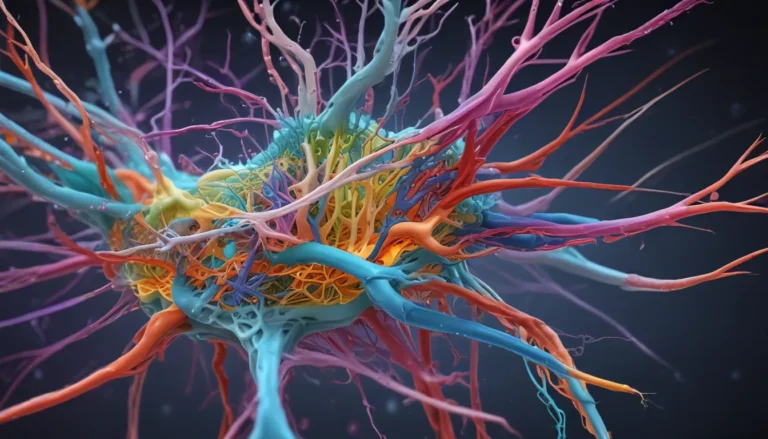A Note About Images: The images used in our articles are for illustration purposes only and may not exactly match the content. They are meant to engage readers, but the text should be relied upon for accurate information.
Are you fascinated by the inner workings of the human body and the molecules that drive essential biological processes? If so, you’re in for a treat as we delve into the intriguing world of cyclic guanosine monophosphate (cGMP). This small but mighty molecule serves as a secondary messenger in signal transduction pathways, influencing a wide range of physiological functions in the human body. Join us on a scientific journey to uncover the secrets of cGMP and gain a deeper understanding of its role in human health and well-being.
Key Takeaways
- cGMP as a Messenger: cGMP acts as a messenger in our body, facilitating communication between cells and responding to signals from hormones and other molecules. Its involvement in muscle relaxation, vision, and brain function showcases its vital role in maintaining homeostasis.
- Significance of cGMP: This molecule plays a crucial role in cellular communication and signal transduction within the body, relaying signals from various molecules to initiate physiological responses.
- Synthesis of cGMP: Derived from Guanosine Triphosphate (GTP), cGMP is synthesized by the enzyme guanylate cyclase, which converts GTP into cGMP to regulate cellular processes.
- Smooth Muscle Relaxation: cGMP is involved in promoting smooth muscle relaxation, particularly in blood vessels, by activating protein kinases that lead to muscle relaxation and blood vessel dilation.
- Role in Vision: In the retina, cGMP regulates phototransduction, allowing for the conversion of light into electrical signals and the transmission of visual information to the brain.
- Viagra’s Mechanism: The erectile dysfunction medication Viagra works by increasing cGMP levels through the inhibition of phosphodiesterase type 5 (PDE5), enhancing blood flow to the penile tissue.
- Platelet Function: cGMP plays a crucial role in regulating platelet function and preventing blood clot formation, contributing to cardiovascular health.
- Cardiac Function: Essential for proper cardiac function, cGMP regulates the contraction and relaxation of cardiac muscle cells, ensuring effective blood pumping.
- Neuronal Activity: cGMP modulates synaptic function and neuronal plasticity in the brain, influencing synaptic transmission, neuronal development, and memory formation.
- Metabolism and Appetite: cGMP signaling may play a role in regulating appetite and energy metabolism, with implications for conditions like obesity and metabolic disorders.
- Neuroprotective Effects: Research suggests that cGMP may have neuroprotective effects against neurodegenerative diseases such as Alzheimer’s and Parkinson’s.
- Gastrointestinal Function: Involved in regulating smooth muscle contraction in the gastrointestinal tract, cGMP aids in digestion and gastrointestinal motility.
- Therapeutic Potential: Due to its significant role in physiological processes, targeting the cGMP signaling pathway for therapeutic interventions shows promise in treating various conditions and diseases.
Unveiling the Fascinating World of CGMP
The Signaling Pathway of CGMP
Cyclic Guanosine Monophosphate (cGMP) serves as a vital signaling molecule within the body, orchestrating cellular communication and contributing to the regulation of numerous physiological processes. As a second messenger, cGMP plays a pivotal role in transmitting signals from hormones, neurotransmitters, and other signaling molecules, initiating a cascade of events that modulate cellular responses. Understanding the intricate signaling pathways of cGMP is essential to grasping its multifaceted functions within the human body.
The Synthesis of CGMP from GTP
Guanosine Triphosphate (GTP) serves as the precursor molecule for cGMP synthesis, a process catalyzed by the enzyme guanylate cyclase. When specific stimuli activate guanylate cyclase, GTP is converted into cGMP, which then acts as a key regulator of cellular processes. This synthesis pathway highlights the dynamic nature of cGMP production and its relevance in maintaining cellular homeostasis.
Smooth Muscle Relaxation and Vasodilation
One of cGMP’s essential functions is promoting smooth muscle relaxation, particularly in the blood vessels. By activating protein kinases, cGMP initiates a cascade of events that lead to muscle relaxation and vasodilation. This process plays a crucial role in regulating blood flow, blood pressure, and overall cardiovascular health, underscoring the importance of cGMP in vascular function.
Nitric Oxide’s Role in CGMP Production
Nitric oxide (NO) serves as a critical regulator of cGMP production, activating guanylate cyclase to convert GTP into cGMP. This activation results in increased cGMP levels, which subsequently trigger various physiological responses, such as vasodilation and platelet inhibition. The intricate interplay between nitric oxide and cGMP underscores the complexity of cellular signaling pathways and their impact on bodily functions.
Vision and Phototransduction
Within the retina, cGMP plays a pivotal role in regulating phototransduction, the process by which light stimuli are converted into electrical signals. As a key component in ion channel regulation, cGMP facilitates the transmission of visual information from photoreceptor cells to the brain, enabling the perception of light and visual images. Its involvement in vision highlights the diverse functions of cGMP beyond traditional signaling pathways.
Therapeutic Implications and Potential Applications
Given its central role in various physiological processes, the cGMP signaling pathway presents an attractive target for therapeutic interventions. By modulating cGMP levels or targeting specific cGMP-regulating enzymes, researchers aim to develop novel treatments for conditions ranging from cardiovascular disorders to neurological diseases. The potential applications of cGMP-based therapies herald a new era in medical research and the quest for innovative treatments for complex health challenges.
Unlocking the Potential of CGMP: A Promising Future
In conclusion, the enigmatic molecule cGMP holds the key to a myriad of biological processes, ranging from muscle relaxation and vision to appetite regulation and neuroprotection. Its intricate signaling pathways and diverse physiological functions underscore its significance in maintaining human health and well-being. As researchers continue to unravel the mysteries of cGMP and explore its therapeutic potential, the future of cellular signaling research shines bright with possibilities for improving human health and advancing medical science.
FAQs
- What is cGMP?
- cGMP stands for cyclic guanosine monophosphate, serving as a crucial second messenger molecule in biological processes.
- How is cGMP produced in the body?
- Synthesized by guanylate cyclase from Guanosine Triphosphate (GTP), cGMP plays a critical role in cellular communication and signal transduction.
- What are the functions of cGMP in the body?
- cGMP regulates muscle relaxation, vasodilation, vision, neurotransmission, and platelet aggregation, among other essential physiological processes.
- Can cGMP be targeted for therapeutic purposes?
- Yes, drugs that modulate cGMP signaling pathways are already used to treat conditions like erectile dysfunction and pulmonary hypertension.
- Are there any diseases associated with cGMP dysregulation?
- Imbalances in cGMP levels have been linked to hypertension, heart failure, erectile dysfunction, and various types of cancers.
- Can cGMP affect vision?
- Yes, cGMP plays a crucial role in visual processes, contributing to the normal functioning of photoreceptor cells in the retina.
- How is cGMP different from cAMP?
- Both molecules are second messengers with distinct physiological roles in different signaling pathways within the body.
- Can cGMP impact the nervous system?
- With its role in neurotransmission and synaptic plasticity, cGMP influences neuronal signaling, mood regulation, and behavioral responses.
Explore the captivating world of cGMP and its implications for human health, paving the way for groundbreaking discoveries in cellular signaling and therapeutic interventions. Join us on this scientific odyssey to unravel the complexities of biological systems and unlock the potential of cellular communication through the dynamic molecule that is cyclic guanosine monophosphate.






